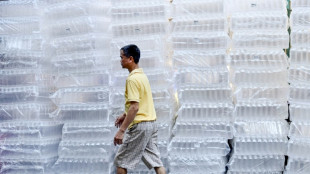

Category 5 Cyclone Mocha set to crash over Myanmar, Bangladesh
Cyclone Mocha intensified into a category five hurricane on Sunday, hours ahead of its predicted landfall in Myanmar and Bangladesh, where hundreds of thousands of people evacuated from the coasts were taking shelter.
Mocha was packing winds of up to 140 knots or 259 kilometres per hour, the US Joint Typhoon Warning Center said, the equivalent to a category 5 hurricane on the Saffir-Simpson Hurricane Wind Scale.
It is forecast to make landfall around 0630 GMT between Cox's Bazar, where nearly one million Rohingya refugees live in camps largely made up of flimsy shelters, and Sittwe on Myanmar's western Rakhine coast.
"The wind is getting stronger at the moment," rescue worker Kyaw Kyaw Khaing told AFP from Pauktaw town, about 25 kilometres inland from Sittwe, and where he said around 3,000 people had arrived to seek shelter.
"We distributed enough food for one or two meals to the people evacuated to temporary shelters. I don't think we will be able to send any food today due to the weather."
Thousands left Sittwe on Saturday, packing into trucks, cars and tuk-tuks and heading for higher ground inland as meteorologists warned of a storm surge of up to 3.5 metres.
"We are not OK because we didn't bring food and other things to cook," said Maung Win, 57, who spent the night in a shelter in Kyauktaw town. "We can only wait to get food from people's donations."
Bangladeshi authorities moved 190,000 people in Cox's Bazar and nearly 100,000 in Chittagong to safety, divisional commissioner Aminur Rahman told AFP late Saturday.
The rain and wind were felt in Myanmar's commercial hub Yangon, around 500 kilometres away, residents said Sunday.
- 'Major emergency' -
The Myanmar Red Cross Society said it was "preparing for a major emergency response".
In Bangladesh, authorities have banned Rohingya refugees from constructing concrete homes, fearing it may incentivise them to settle permanently rather than return to Myanmar, which they fled five years ago following a brutal military crackdown.
"We live in houses made of tarpaulin and bamboo," said refugee Enam Ahmed, at the Nayapara camp near the border town of Teknaf.
"We are scared. We don't know where we will be sheltered."
The camps are generally slightly inland, but most of them are built on hillsides, exposing them to the threat of landslides.
Forecasters expect the cyclone to bring a deluge of rain, which can trigger landslips.
Officials moved to evacuate Rohingya refugees from "risky areas" to community centres and more solid structures such as schools.
But Bangladesh's deputy refugee commissioner Shamsud Douza told AFP: "All the Rohingyas in the camps are at risk."
Hundreds of people also fled Saint Martin's island, a local resort area right in the storm's path, with thousands more moving to cyclone shelters on the coral outcrop.
"Cyclone Mocha is the most powerful storm since Cyclone Sidr," Azizur Rahman, the head of Bangladesh's Meteorological Department, told AFP.
Sidr hit Bangladesh's southern coast in November 2007, killing more than 3,000 people and causing billions of dollars in damage.
Rohingya living in displacement camps inside Myanmar were also bracing for the storm.
"We are very worried. We can be in danger if the water level increases," said a camp leader near Kyaukphyu in Rakhine state, who asked not to be named for fear of repercussions from the junta.
"There are about 1000 people at the camp... The authorities only gave us rice bags, oil and five life jackets. Local authorities haven't arranged any place for us."
Operations were suspended at Bangladesh's largest seaport, Chittagong, with boat transport and fishing also halted.
Cyclones -- the equivalent of hurricanes in the North Atlantic or typhoons in the Northwest Pacific -- are a regular and deadly menace on the coast of the northern Indian Ocean where tens of millions of people live.
str-sa-lpk-rma/pdw/sco
R.Abreu--ESF



